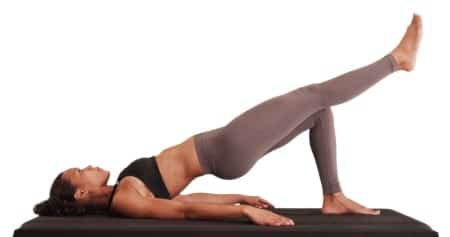Exercises against lower back pain for a stronger back
Lower back pain comes in two ways. Either you get it slowly but surely, for example after sitting for a long time with a poor posture, or it comes as a sudden stabbing pain after a wrong movement. No matter how quickly or slowly lower back pain occurs, it is always difficult to get rid of. Fortunately, there are exercises against lower back pain. They help you get rid of the pain faster and directly strengthen your back for the future. Follow our tips and say good-by to lower back pain forever.
Note: The exercises described below are general exercises to support your back. If you have a specific medical issue, you should always first consult your family doctor and personal therapist.
Lower back pain comes from an interaction of causes
A hereditary disorder, a collapsed vertebra, or an infection – it could be, but lower back pain usually has a different cause. Or better said: other causes, because lower back pain is an unpleasant result of the interaction between muscles, tendons and joints. That’s the nub of it.
Do you suffer from lower back pain? Then first the good news: your vertebrae are probably still in good condition. Even if you find it difficult to move, you need not directly fear a hernia or worse. If you want to be sure, consult your family doctor.
Ouf. So you don’t have to directly fear a serious injury. But that doesn’t put an end to the irritating pain in your lower back. For that you must first cultivate a number of habits.
Sit as straight as possible and tip your pelvis
Do you lead a sedentary life? You’re not the only one. Many people spend an average of 8 hours a day sitting on a chair. That’s bad for the back, because it becomes weak and lazy. Constantly sitting leads to stiff hip muscles, weak gluteus muscles and poor circulation
If you can choose between sitting and standing at work, for example during meetings, you should choose to stand. If you do sit, sit straight up. Tip your pelvis slightly forward, with your shoulders a bit to the rear.

Sleep ergonomically
Your back likes to lie down sometimes. Then the muscles can rest, the intervertebral discs can relax, and the joints are not pressed together. You can also help your spinal column by adopting a good sleeping position and choosing ergonomic sleep comfort. Also think about your posture when lying back in your chair. An additional cushion can provide suitable support.
Make your back more limber
These exercises make your back more flexible. Being as limber as a cat is more than you can expect, but they can help you become as limber as possible.
1. Back arch on hands and knees
- Rest on your hands and knees.
- Make your back alternately concave and convex.
- Hold each position for two seconds.
- Gradually build up the exercises: do four sets of ten movements in the first week, four sets of fifteen movements in the second week, and four sets of twenty movements from the third week onwards.

2. Back arch on your back
- Lie on your back with your legs bent and your lower back just above the ground.
- Press your lower back against the ground, then make it as concave as possible.
- Hold each position for two seconds.
- Gradually build up the exercises: do four sets of ten movements in the first week, four sets of fifteen movements in the second week, and four sets of twenty movements from the third week onwards.
Strengthen your back muscles
Strong back muscles ensure a stable back posture. These exercises help you improve the condition of your lower back:
1. Strong like Superman
- Rest on your hands and knees and extend one leg horizontally.
- Extend the opposite arm.
- Bring your hand and knee together and stretch them out again.
- Hold each position for ten seconds.
- Gradually build up the exercises: do four sets of ten movements in the first week, four sets of fifteen movements in the second week, and four sets of twenty movements from the third week onwards.

2. Make a bridge
- Lie on your back with your legs bent and your arms spread on the ground.
- Push your bottom upwards.
- Extend one leg upwards at an angle.
- Hold this position for ten seconds.
- Gradually build up the exercises: do four sets of ten movements in the first week, four sets of fifteen movements in the second week, and four sets of twenty movements from the third week onwards.

Stretch your back
Stretching you back makes it more resilient. You should only do these exercises if they do not cause any pain.
1. Knees against your chest
- Lie on your back and bend your legs.
- Raise your knees up to your chest.
- You may also lift your head; that stretches you back even more.
- Hold this position for ten seconds.
- Gradually build up the exercises: do four sets of ten movements in the first week, four sets of fifteen movements in the second week, and four sets of twenty movements from the third week onwards.

2. Long back
- Rest on your hands and knees.
- Move your bottom so it rests on your heels.
- Stretch your arms out as far as possible on the ground.
- Hold this position for ten seconds.
- Gradually build up the exercises: do four sets of ten movements in the first week, four sets of fifteen movements in the second week, and four sets of twenty movements from the third week onwards.



